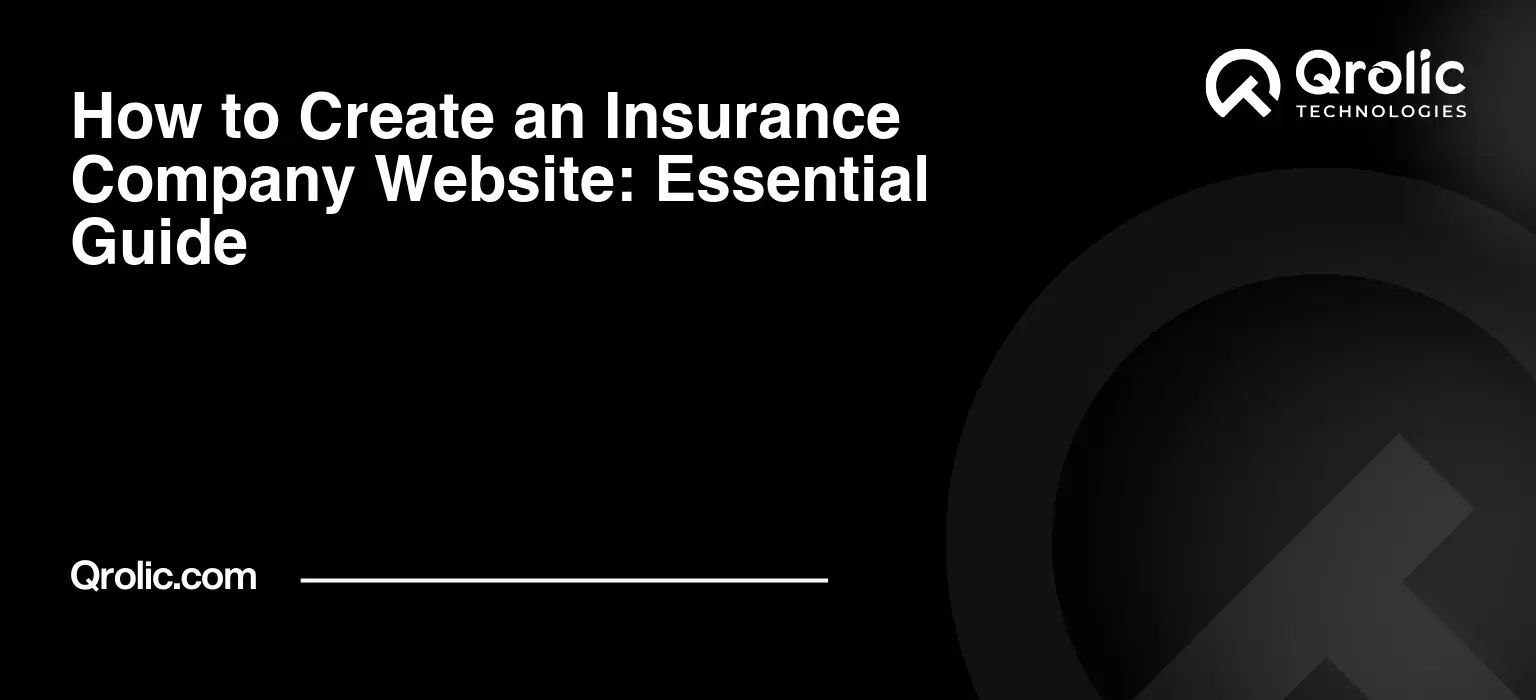Creating a powerful online presence is no longer optional for insurance consultants; it’s essential for survival and growth. Your website is your digital storefront, your 24/7 salesperson, and the cornerstone of your marketing efforts. This comprehensive guide will walk you through the essential steps of creating an insurance consultant website that attracts clients, establishes credibility, and drives conversions.
Quick Summary:
- Plan your website: know your audience and goals.
- Build a user-friendly site with great content.
- Optimize for search and promote your website widely.
- Track performance and ensure legal compliance.
Table of Contents
- I. Laying the Foundation: Planning & Strategy
- A. Defining Your Target Audience: Who Are You Serving?
- B. Setting Clear Goals: What Do You Want to Achieve?
- C. Competitive Analysis: Understanding the Landscape
- II. Choosing the Right Platform: Technology & Tools
- A. Website Builders vs. CMS: Weighing the Options
- B. Hosting: Selecting a Reliable Provider
- C. Domain Name: Choosing a Memorable Address
- III. Designing for Success: User Experience & Visual Appeal
- A. User-Friendly Navigation: Making it Easy to Find Information
- B. Mobile Responsiveness: Reaching Customers on Any Device
- C. Visual Branding: Creating a Consistent Identity
- IV. Content is King: Creating Valuable & Engaging Material
- A. Service Pages: Showcasing Your Expertise
- B. Blog Posts: Establishing Authority & Providing Value
- C. Lead Magnets: Attracting Potential Clients
- V. SEO Optimization: Getting Found Online
- A. Keyword Research: Identifying Relevant Terms
- B. On-Page Optimization: Optimizing Your Website for Search Engines
- C. Off-Page Optimization: Building Authority & Backlinks
- VI. Promoting Your Website: Driving Traffic & Generating Leads
- A. Social Media Marketing: Engaging Your Audience
- B. Email Marketing: Nurturing Leads & Building Relationships
- C. Paid Advertising: Reaching a Wider Audience
- VII. Analytics & Optimization: Measuring Success & Making Improvements
- A. Google Analytics: Tracking Website Traffic & Behavior
- B. A/B Testing: Optimizing Your Website for Conversions
- C. Gathering Feedback: Understanding Your Audience’s Needs
- VIII. Legal and Compliance: Ensuring You’re Covered
- A. Privacy Policy: Protecting User Data
- B. Disclaimers: Limiting Liability
- C. Accessibility: Ensuring Inclusivity
- IX. Qrolic Technologies: Your Partner in Digital Success
- X. Conclusion: Your Online Journey Starts Now
I. Laying the Foundation: Planning & Strategy

Before diving into design and coding, a robust plan will save you time, money, and frustration. This phase focuses on defining your target audience, setting clear goals, and understanding your competitive landscape.
A. Defining Your Target Audience: Who Are You Serving?
Understanding your ideal client is paramount. Generic websites appeal to no one. Niche down and speak directly to the needs and desires of your target demographic.
- Demographics: Consider age, income level, location, occupation, and education. Are you targeting young families seeking life insurance, retirees needing Medicare supplements, or small business owners requiring commercial coverage?
- Psychographics: Delve into their values, interests, lifestyle, and pain points. What are their fears and aspirations regarding insurance? What keeps them up at night? What are their biggest challenges when it comes to navigating the complex world of insurance?
- Insurance Needs: What specific insurance products are they likely to be interested in? Life insurance, health insurance, auto insurance, home insurance, business insurance, disability insurance, long-term care insurance?
- Online Behavior: Where do they spend their time online? What websites do they visit? What social media platforms do they use? What keywords do they use when searching for insurance information?
Example:
Let’s say you want to target young families. Your ideal client might be:
- Demographics: 30-45 years old, married with children, middle-class income, living in suburban areas.
- Psychographics: Concerned about protecting their family’s future, value security and stability, seek affordable solutions, overwhelmed by insurance jargon.
- Insurance Needs: Life insurance, health insurance, auto insurance, home insurance.
- Online Behavior: Active on Facebook and Instagram, read parenting blogs, research products online before purchasing.
Knowing this information allows you to tailor your website’s content, design, and marketing messages to resonate with this specific audience. This ensures you are attract those you serve.
B. Setting Clear Goals: What Do You Want to Achieve?
What do you want your website to accomplish? Defining measurable goals provides direction and allows you to track your progress.
- Lead Generation: Capture contact information from potential clients. This could be through contact forms, quote requests, or free resource downloads.
- Appointment Booking: Allow visitors to schedule consultations directly through your website.
- Brand Awareness: Establish your authority and expertise in the insurance industry.
- Direct Sales: Sell insurance products online (if applicable and compliant with regulations).
- Customer Service: Provide resources and support for existing clients.
- Informational Resource: Give educational material in a blog format.
Example:
- Increase lead generation by 20% in the next quarter.
- Schedule 10 new appointments per week through the website.
- Increase Website Traffic by 50% in the next six months.
- Lower bounce rate by 15% in the next three months.
- Achieve 50 email sign ups a month.
Setting SMART (Specific, Measurable, Achievable, Relevant, Time-bound) goals will help you stay focused and motivated.
C. Competitive Analysis: Understanding the Landscape
Analyze the websites of your competitors. What are they doing well? Where can you differentiate yourself?
- Identify Competitors: Search online for insurance consultants in your area. Who are the top players?
- Analyze Their Websites: Examine their design, content, user experience, and SEO strategies.
- Identify Strengths and Weaknesses: What are they doing well? What could they improve?
- Find Opportunities: Where can you differentiate yourself? What needs are they not addressing? How can you provide a better experience?
- SEO keywords they rank for: See what keywords you can use that your competitors are using to attract more users.
Questions to ask when analyzing competitor websites:
- What is their unique selling proposition (USP)?
- What type of content do they offer?
- How easy is it to navigate their website?
- Do they have a blog?
- Are they using social media effectively?
- How do they handle customer service?
- What are their pricing strategies?
By understanding your competition, you can create a website that stands out and provides more value to your target audience.
II. Choosing the Right Platform: Technology & Tools
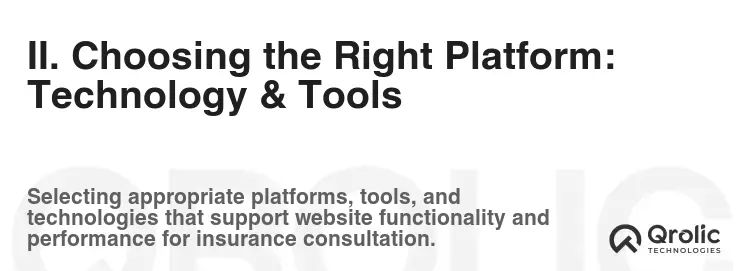
Selecting the appropriate platform is crucial for building a user-friendly, scalable, and SEO-friendly website.
A. Website Builders vs. CMS: Weighing the Options
Two main options exist: website builders (e.g., Wix, Squarespace) and content management systems (CMS) like wordpress.
- Website Builders: Offer ease of use and drag-and-drop functionality, ideal for beginners. However, they can be limited in terms of customization and SEO.
- Content Management Systems (CMS): Provide greater flexibility, control, and scalability, but require more technical expertise.
Considerations:
- Technical Skills: How comfortable are you with web design and development?
- Budget: Website builders often have lower upfront costs but may have ongoing subscription fees. CMS platforms like WordPress are free, but you’ll need to pay for hosting and potentially premium themes or plugins.
- Scalability: Will your website need to grow and evolve over time? CMS platforms generally offer more scalability.
- SEO: WordPress, with the right plugins (like Yoast SEO or Rank Math), provides excellent SEO capabilities.
Recommendation:
For most insurance consultants, WordPress is the preferred choice. It offers a balance of flexibility, scalability, and SEO capabilities. While it requires a slightly steeper learning curve, the benefits outweigh the drawbacks in the long run.
B. Hosting: Selecting a Reliable Provider
Your hosting provider stores your website’s files and makes it accessible to visitors. Choose a reliable provider with fast loading speeds and excellent uptime.
- Shared Hosting: Affordable but can be slow and unreliable.
- VPS Hosting: Offers more resources and control than shared hosting.
- Dedicated Hosting: Provides the highest level of performance and security, but is the most expensive.
- Managed WordPress Hosting: Optimized for WordPress websites, offering features like automatic updates and security scans.
Factors to consider:
- Uptime: Look for a provider with at least 99.9% uptime.
- Speed: Choose a provider with fast servers and optimized infrastructure.
- Security: Ensure the provider offers robust security measures, such as firewalls and malware scanning.
- Customer Support: Look for a provider with 24/7 customer support.
- Scalability: Can the provider accommodate your website’s growth?
- Price: Compare pricing plans and features to find the best value.
Popular Hosting Providers:
- Bluehost
- SiteGround
- HostGator
- WP Engine (Managed WordPress Hosting)
- Kinsta (Managed WordPress Hosting)
C. Domain Name: Choosing a Memorable Address
Your domain name is your website’s address. Choose a name that is memorable, relevant, and easy to spell.
- Relevance: The domain name should reflect your brand and the services you offer.
- Memorability: Choose a name that is easy to remember and pronounce.
- Brevity: Keep the domain name short and concise.
- Availability: Check if the domain name is available before registering it.
- Extension: Choose a common extension like .com, .net, or .org. Consider a local extension like .ca or .uk if you primarily serve a specific geographic area.
Tips for choosing a domain name:
- Include relevant keywords (e.g., “insurance,” “financial,” “advisor”).
- Use your name or company name.
- Consider a location-based domain name (e.g., “chicagolifeinsurance.com”).
- Check for trademark issues before registering the domain name.
III. Designing for Success: User Experience & Visual Appeal
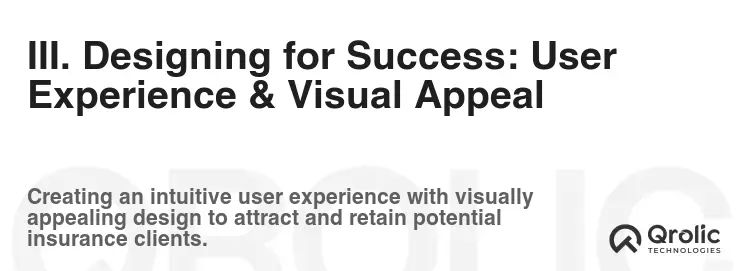
Your website’s design plays a crucial role in attracting and retaining visitors. A well-designed website is user-friendly, visually appealing, and mobile-responsive.
A. User-Friendly Navigation: Making it Easy to Find Information
Ensure visitors can easily find the information they need. A clear and intuitive navigation system is essential.
- Simple Menu Structure: Use a clear and concise menu structure.
- Logical Hierarchy: Organize content in a logical and intuitive way.
- Search Functionality: Provide a search bar so visitors can quickly find specific information.
- Call to Actions (CTAs): Use clear and prominent CTAs to guide visitors through the website.
Best Practices:
- Use a consistent navigation menu throughout the website.
- Limit the number of menu items to avoid overwhelming visitors.
- Use descriptive labels for menu items.
- Make the navigation menu mobile-friendly.
B. Mobile Responsiveness: Reaching Customers on Any Device
Ensure your website looks and functions flawlessly on all devices, including desktops, laptops, tablets, and smartphones.
- Responsive Design: Use a responsive design framework that adapts to different screen sizes.
- Mobile-First Approach: Design for mobile devices first, then scale up to larger screens.
- Test on Multiple Devices: Test your website on different devices and browsers to ensure it looks and functions correctly.
Why is mobile responsiveness important?
- Mobile Traffic: A significant portion of website traffic comes from mobile devices.
- SEO: Google prioritizes mobile-friendly websites in search results.
- User Experience: A mobile-friendly website provides a better user experience for mobile users.
C. Visual Branding: Creating a Consistent Identity
Establish a consistent visual brand across your website, including your logo, colors, fonts, and imagery.
- Logo: Use a professional and memorable logo that represents your brand.
- Color Palette: Choose a color palette that reflects your brand and appeals to your target audience.
- Typography: Use consistent fonts throughout the website.
- Imagery: Use high-quality images and videos that are relevant to your brand and content.
Tips for creating a strong visual brand:
- Research your target audience and competitors to understand their preferences.
- Create a style guide to ensure consistency across all marketing materials.
- Use professional design tools and resources.
IV. Content is King: Creating Valuable & Engaging Material
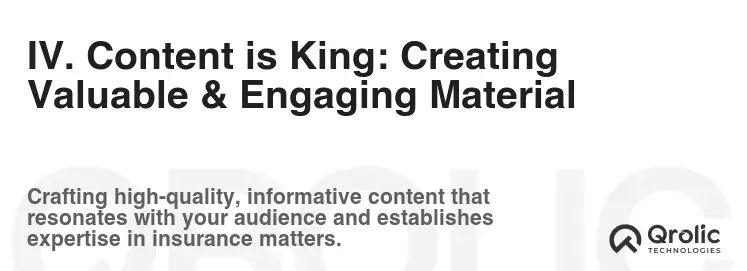
High-quality content is the heart of your website. It attracts visitors, establishes credibility, and drives conversions.
A. Service Pages: Showcasing Your Expertise
Clearly outline the insurance products and services you offer.
- Detailed Descriptions: Provide detailed descriptions of each service, highlighting the benefits and features.
- Targeted Keywords: Use relevant keywords to optimize your service pages for search engines.
- Case Studies: Showcase successful case studies to demonstrate your expertise.
- Testimonials: Include testimonials from satisfied clients to build trust.
Example Service Pages:
- Life Insurance
- Health Insurance
- Auto Insurance
- Home Insurance
- Business Insurance
- Retirement Planning
B. Blog Posts: Establishing Authority & Providing Value
Create informative and engaging blog posts that address the needs and interests of your target audience.
- Keyword Research: Identify relevant keywords and topics that your target audience is searching for.
- Informative Content: Provide valuable information and insights that help your audience make informed decisions.
- Engaging Style: Write in a clear, concise, and engaging style.
- Visual Content: Include images, videos, and infographics to break up the text and make the content more appealing.
- Call to Actions: Include clear CTAs to encourage readers to take the next step.
Blog Post Ideas for Insurance Consultants:
- “Understanding the Different Types of Life Insurance”
- “How to Choose the Right Health Insurance Plan”
- “Tips for Saving Money on Auto Insurance”
- “Protecting Your Home with Homeowners Insurance”
- “The Importance of Business Insurance for Small Business Owners”
- “Retirement Planning Strategies for a Secure Future”
- “Affordable life insurance”
- “Term Vs. Whole Life Insurance”
- “What is supplemental insurance and do you need it”
- “Insurance for your growing family”
C. Lead Magnets: Attracting Potential Clients
Offer valuable free resources in exchange for contact information.
- Ebooks: Create informative ebooks on topics related to insurance and financial planning.
- Checklists: Develop checklists that help your audience with specific tasks (e.g., “Home Insurance Checklist”).
- Templates: Provide templates for creating insurance plans or financial budgets.
- Webinars: Host webinars on relevant topics and offer a free recording to those who register.
- Consultation: Offer a free initial consultation
Examples:
- “Free Guide to Choosing the Right Life Insurance Policy”
- “Downloadable Checklist for Protecting Your Home”
- “Free Retirement Planning Calculator”
V. SEO Optimization: Getting Found Online
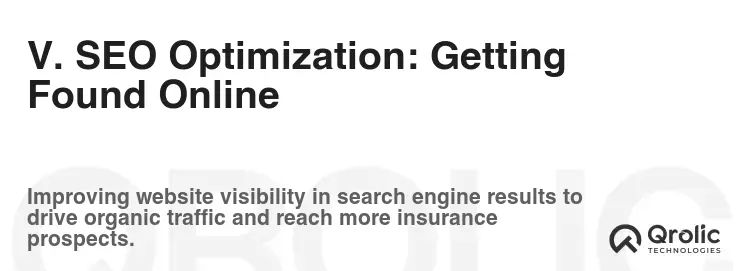
Search engine optimization (SEO) is crucial for driving organic traffic to your website.
A. Keyword Research: Identifying Relevant Terms
Identify the keywords that your target audience is using to search for insurance information online.
- Google Keyword Planner: Use Google Keyword Planner to research keywords and analyze their search volume and competition.
- SEMrush: Use SEMrush to analyze your competitors’ keywords and identify new opportunities.
- Ahrefs: Use Ahrefs to track your website’s ranking and identify areas for improvement.
- Long-Tail Keywords: Focus on long-tail keywords (longer, more specific phrases) to attract highly targeted traffic.
Examples:
- “affordable life insurance for families”
- “best health insurance for small business owners”
- “cheap car insurance quotes online”
- “home insurance rates [your city]”
- “retirement planning advice for seniors”
B. On-Page Optimization: Optimizing Your Website for Search Engines
Optimize your website’s content, meta tags, and URL structure for search engines.
- Title Tags: Include your target keywords in your title tags.
- Meta Descriptions: Write compelling meta descriptions that entice users to click on your website in search results.
- Header Tags: Use header tags (H1, H2, H3) to structure your content and highlight important keywords.
- URL Structure: Use clean and descriptive URLs that include your target keywords.
- Image Optimization: Optimize your images by using descriptive alt text and compressing them to reduce file size.
- Internal Linking: Link to other relevant pages on your website to improve navigation and SEO.
C. Off-Page Optimization: Building Authority & Backlinks
Build authority and backlinks from other reputable websites in your industry.
- Guest Blogging: Write guest posts for other websites in your industry and include a link back to your website.
- Directory Listings: List your website in relevant online directories.
- Social Media: Share your content on social media to reach a wider audience.
- Link Building: Earn backlinks from other websites by creating high-quality content that people want to link to.
- Testimonials: Ask clients to give testimonials about your services
VI. Promoting Your Website: Driving Traffic & Generating Leads

Once your website is live, you need to promote it to drive traffic and generate leads.
A. Social Media Marketing: Engaging Your Audience
Use social media to connect with your target audience, share valuable content, and promote your services.
- Choose the Right Platforms: Focus on the social media platforms that your target audience uses most.
- Create Engaging Content: Share valuable content that is relevant to your audience’s interests.
- Engage with Your Followers: Respond to comments and questions promptly.
- Run Contests and Giveaways: Run contests and giveaways to attract new followers and generate leads.
- Use Paid Advertising: Use paid advertising to reach a wider audience.
B. Email Marketing: Nurturing Leads & Building Relationships
Build an email list and send regular newsletters to nurture leads and build relationships with potential clients.
- Offer a Lead Magnet: Offer a valuable lead magnet in exchange for email addresses.
- Segment Your List: Segment your email list based on interests and demographics.
- Send Regular Newsletters: Send regular newsletters with valuable content, special offers, and industry news.
- Personalize Your Emails: Personalize your emails to make them more relevant to each recipient.
- Track Your Results: Track your email marketing results to see what is working and what is not.
C. Paid Advertising: Reaching a Wider Audience
Use paid advertising platforms like Google Ads and social media ads to reach a wider audience and generate leads.
- Google Ads: Use Google Ads to target potential clients who are searching for insurance information online.
- Social Media Ads: Use social media ads to target potential clients based on their demographics, interests, and behaviors.
- Retargeting: Use retargeting ads to target visitors who have previously visited your website.
- Track Your Results: Track your advertising results to see what is working and what is not.
VII. Analytics & Optimization: Measuring Success & Making Improvements
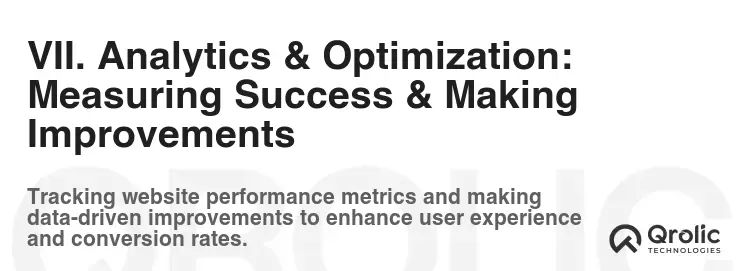
Continuously monitor your website’s performance and make improvements based on data and feedback.
A. Google Analytics: Tracking Website Traffic & Behavior
Use Google Analytics to track website traffic, user behavior, and conversions.
- Traffic Sources: Identify where your website traffic is coming from.
- Bounce Rate: Track your website’s bounce rate to see if visitors are leaving your website quickly.
- Time on Site: Track how long visitors are spending on your website.
- Conversion Rates: Track your website’s conversion rates to see how many visitors are converting into leads or customers.
B. A/B Testing: Optimizing Your Website for Conversions
Use A/B testing to experiment with different versions of your website and see which ones perform better.
- Test Headlines: Test different headlines to see which ones attract more clicks.
- Test Call to Actions: Test different call to actions to see which ones generate more leads.
- Test Landing Pages: Test different landing pages to see which ones convert more visitors into leads or customers.
- Test Website copy: Test which words sell the most.
C. Gathering Feedback: Understanding Your Audience’s Needs
Solicit feedback from your website visitors and clients to understand their needs and improve your website.
- Surveys: Conduct surveys to gather feedback on your website and services.
- Feedback Forms: Add feedback forms to your website to allow visitors to provide feedback.
- Customer Reviews: Encourage clients to leave reviews on your website and other online platforms.
- Read forums: See what the general problems are in the market for insurance.
VIII. Legal and Compliance: Ensuring You’re Covered
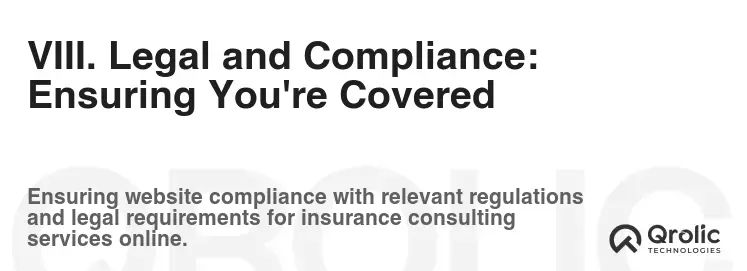
Insurance is a heavily regulated industry. Ensure your website complies with all applicable laws and regulations.
A. Privacy Policy: Protecting User Data
Have a clear and comprehensive privacy policy that outlines how you collect, use, and protect user data.
- Data Collection: Explain what types of data you collect from visitors.
- Data Usage: Explain how you use the data you collect.
- Data Security: Explain how you protect user data from unauthorized access.
- Compliance: Ensure your privacy policy complies with all applicable laws and regulations, such as GDPR and CCPA.
B. Disclaimers: Limiting Liability
Include disclaimers on your website to limit your liability.
- Accuracy of Information: Disclaim responsibility for the accuracy of information provided on the website.
- Financial Advice: Disclaim that the information on the website is not financial advice.
- Insurance Coverage: Disclaim that the information on the website does not guarantee insurance coverage.
- Affiliate Links: Disclose any affiliate links on the website.
C. Accessibility: Ensuring Inclusivity
Make your website accessible to people with disabilities.
- WCAG Compliance: Follow the Web Content Accessibility Guidelines (WCAG).
- Alt Text for Images: Provide alt text for all images.
- Keyboard Navigation: Ensure your website can be navigated using a keyboard.
- Color Contrast: Use sufficient color contrast to make the text readable.
- Screen Reader Compatibility: Ensure your website is compatible with screen readers.
IX. Qrolic Technologies: Your Partner in Digital Success

Creating a website is only the first step. To truly thrive in the digital landscape, you need a partner who understands the complexities of Web Development, SEO, and digital marketing. That’s where Qrolic Technologies comes in.
Qrolic Technologies is a leading provider of web development, design, and digital marketing services, specializing in helping businesses like yours achieve online success. With years of experience and a team of dedicated professionals, Qrolic Technologies can help you build a website that not only looks great but also drives traffic, generates leads, and converts visitors into loyal customers.
Here’s how Qrolic Technologies can help:
- Custom Website Design and Development: Qrolic Technologies can create a custom website that reflects your brand and meets your specific needs.
- SEO Optimization: Qrolic Technologies can optimize your website for search engines, helping you rank higher in search results and attract more organic traffic.
- Content Marketing: Qrolic Technologies can create high-quality content that attracts and engages your target audience.
- Social Media Marketing: Qrolic Technologies can help you build a strong social media presence and connect with potential clients.
- Paid Advertising: Qrolic Technologies can help you run effective paid advertising campaigns that generate leads and drive conversions.
- Website Maintenance and Support: Qrolic Technologies provides ongoing website maintenance and support to ensure your website is always up-to-date and running smoothly.
Contact Qrolic Technologies today at https://qrolic.com/ to learn more about how we can help you achieve your online goals.
X. Conclusion: Your Online Journey Starts Now

Creating a successful insurance consultant website is a journey, not a destination. By following these essential steps, you can build a website that attracts clients, establishes credibility, and drives conversions. Remember to continuously monitor your website’s performance, gather feedback, and make improvements based on data and insights. With dedication and the right approach, you can establish a strong online presence and achieve your business goals. Don’t be afraid to invest in professional help where needed.

